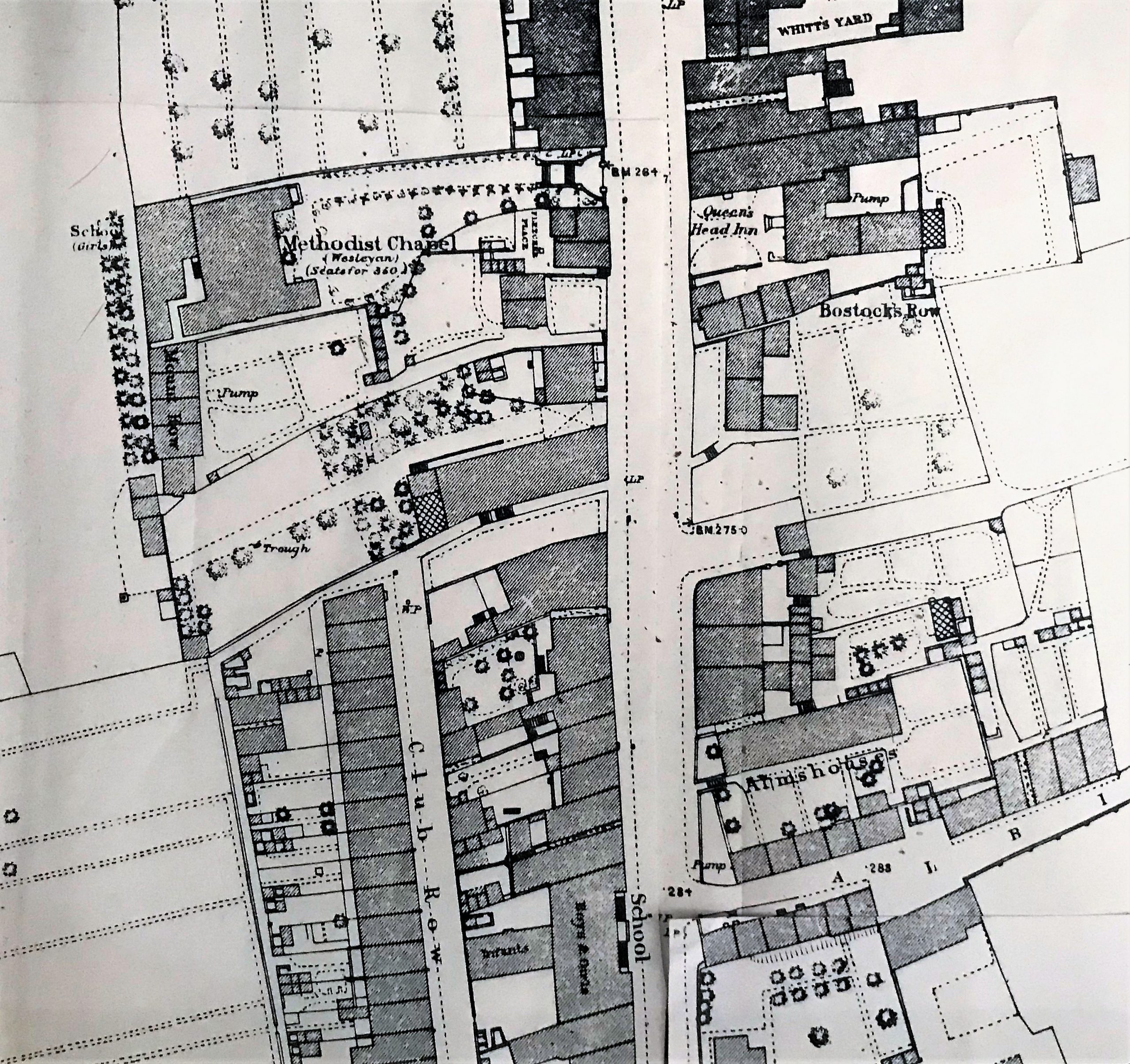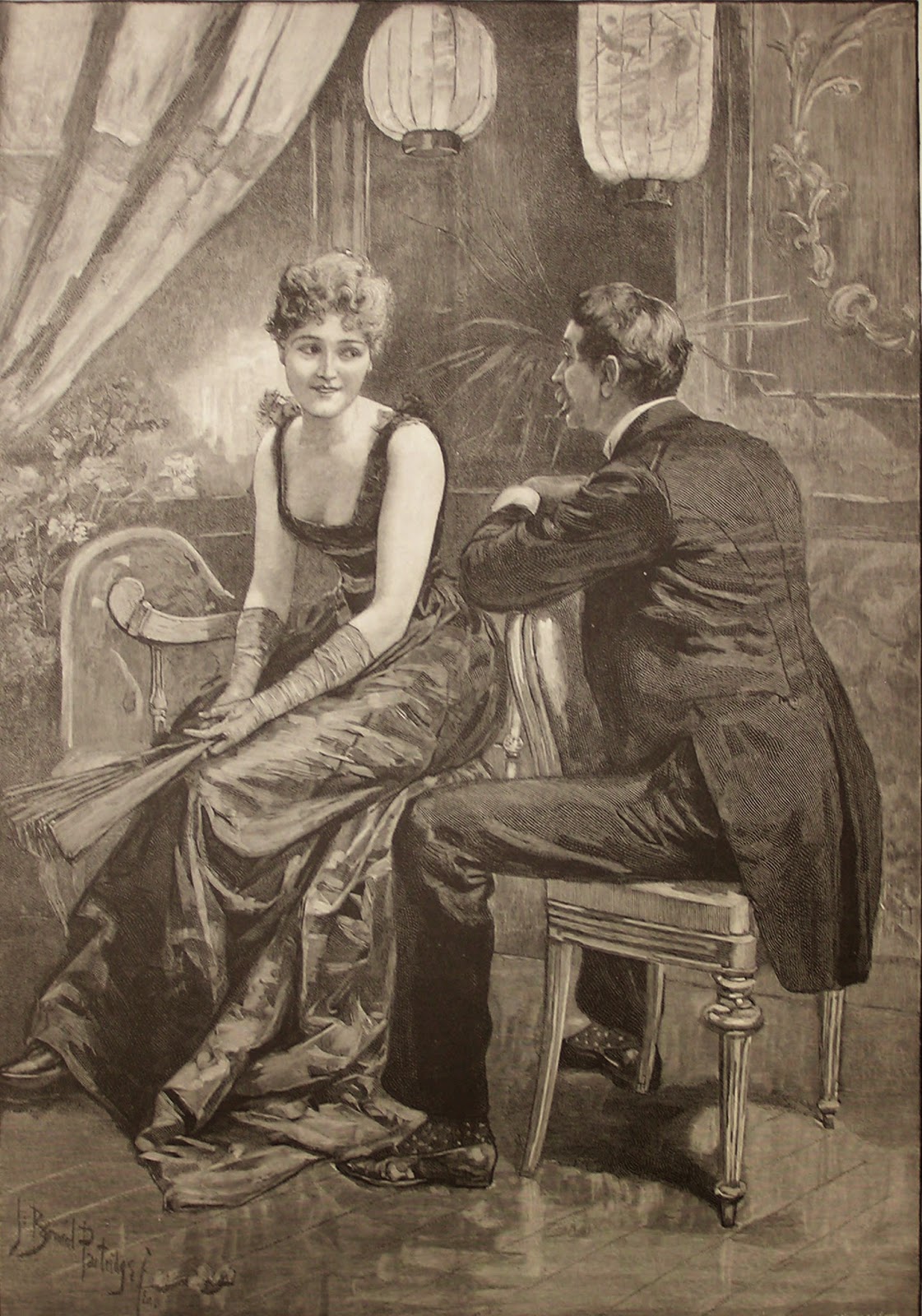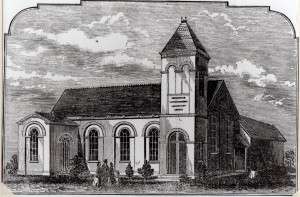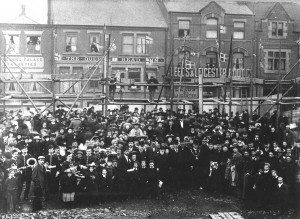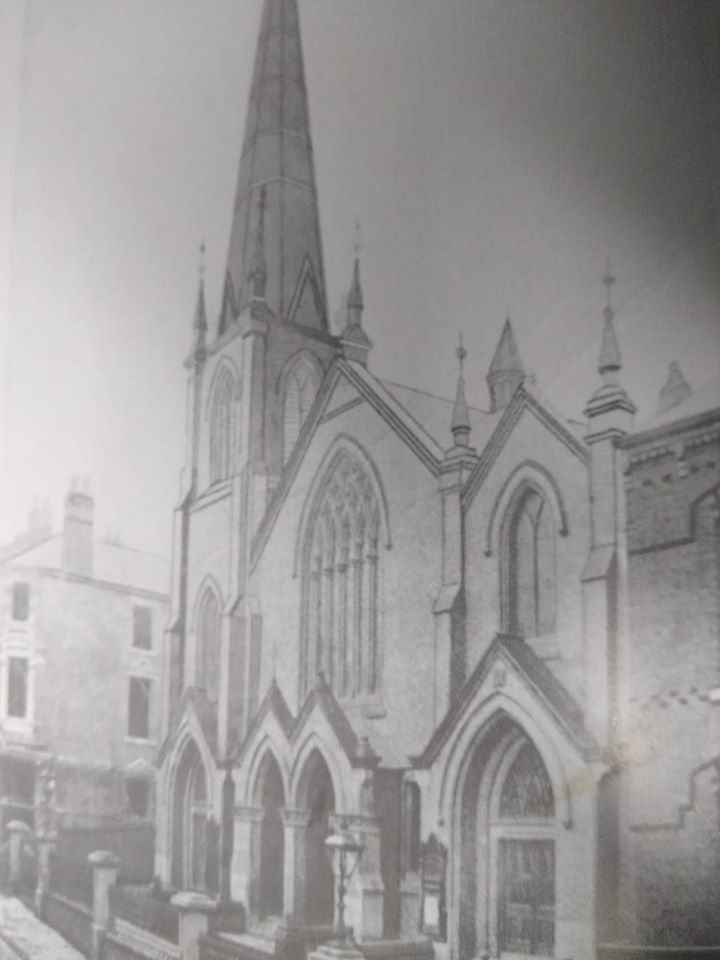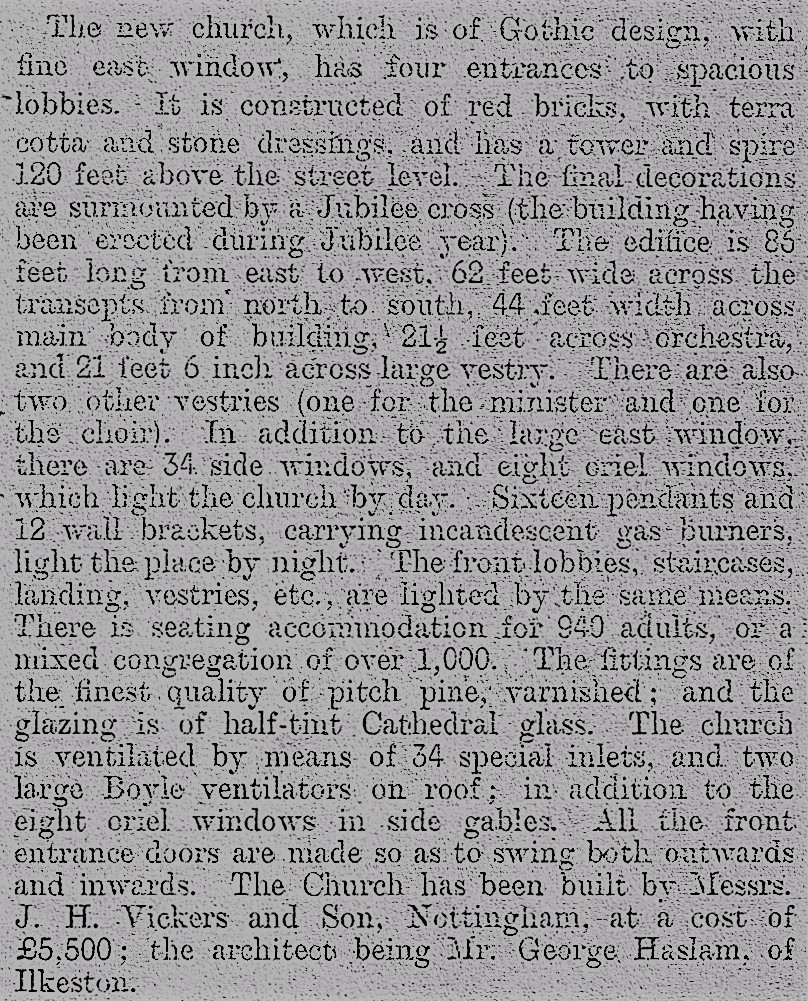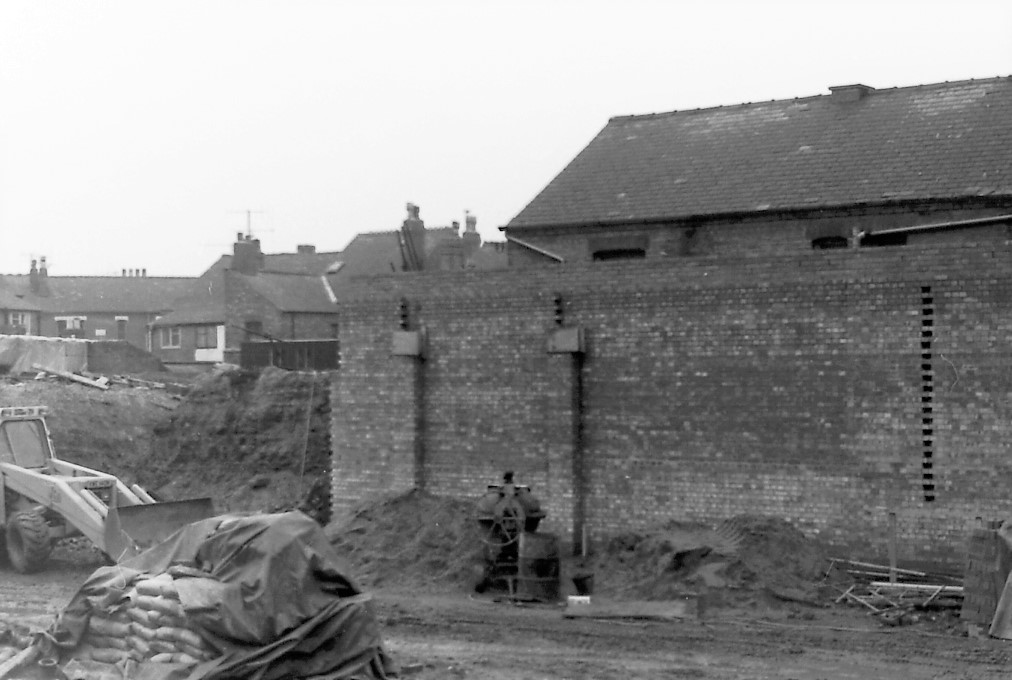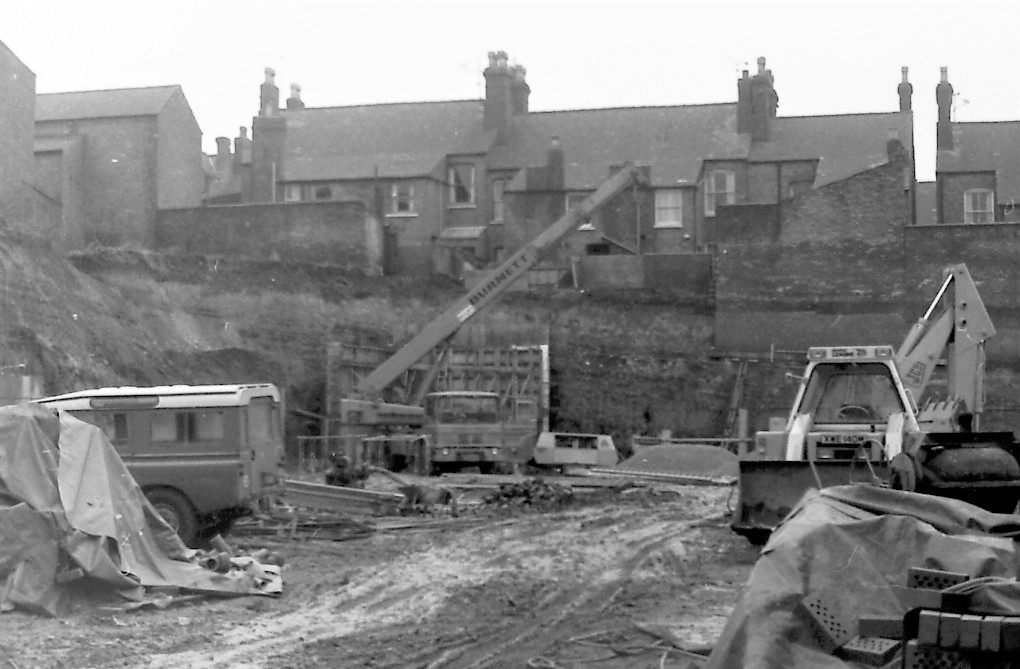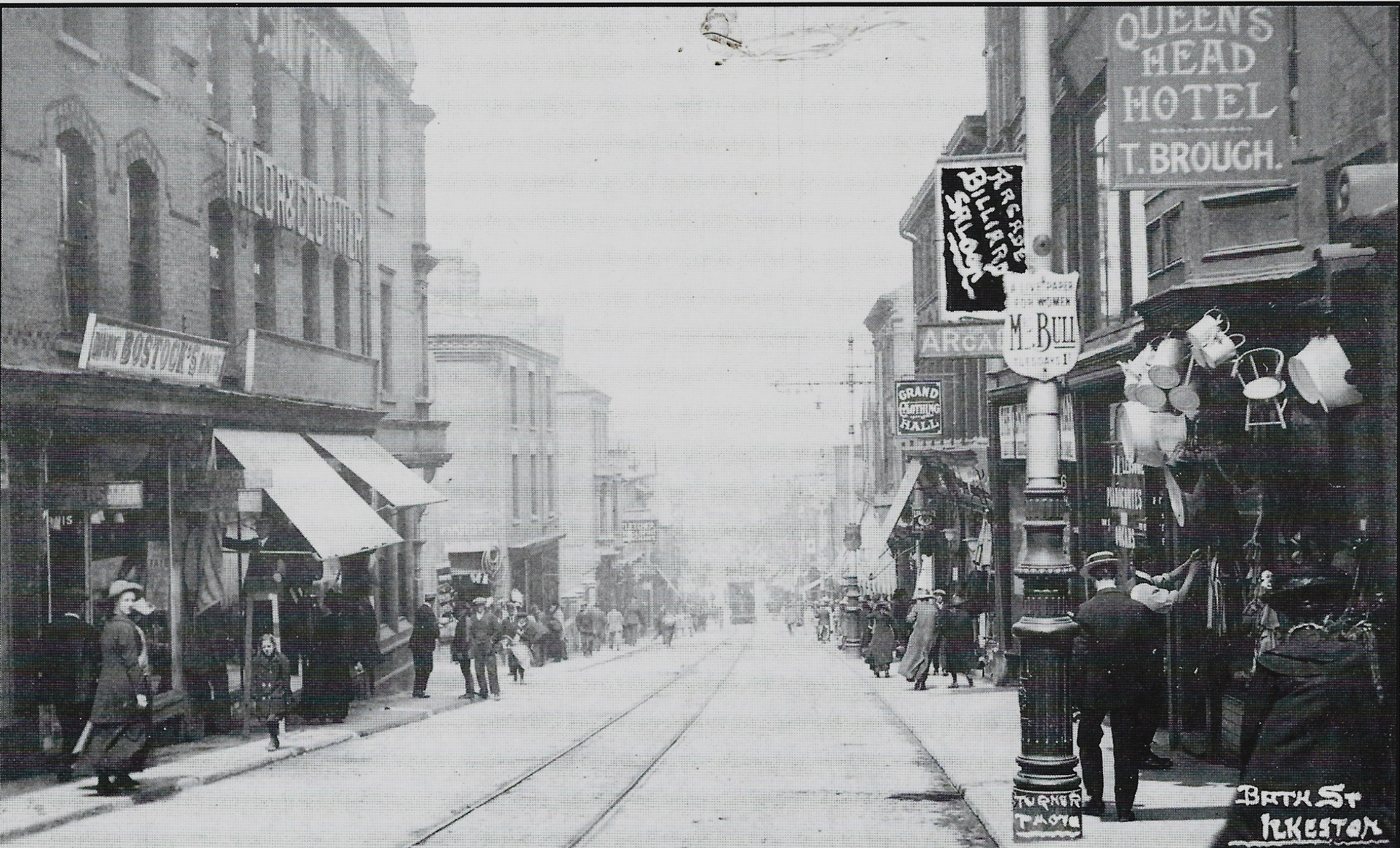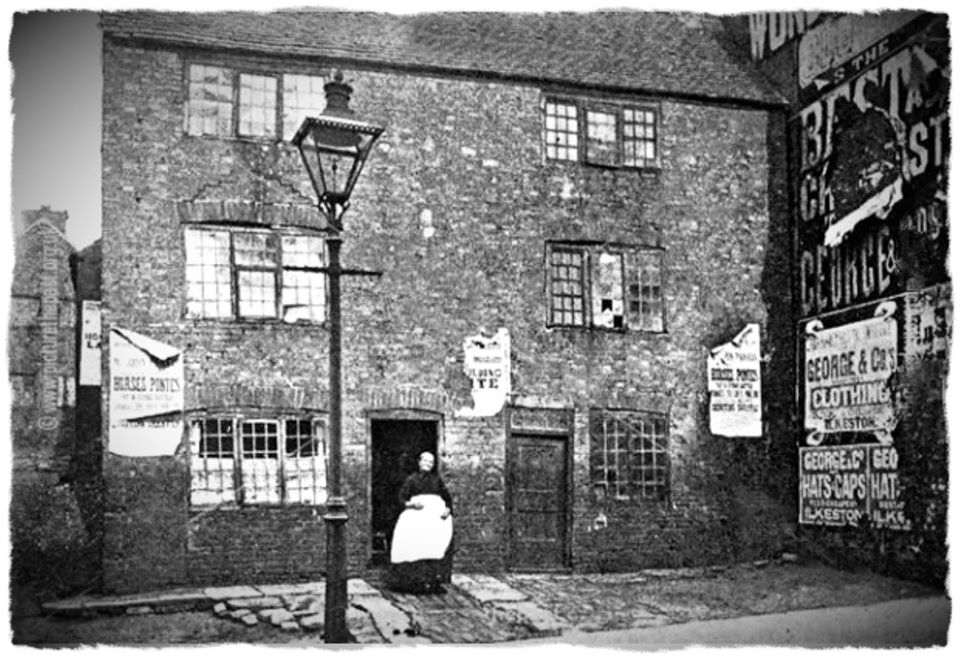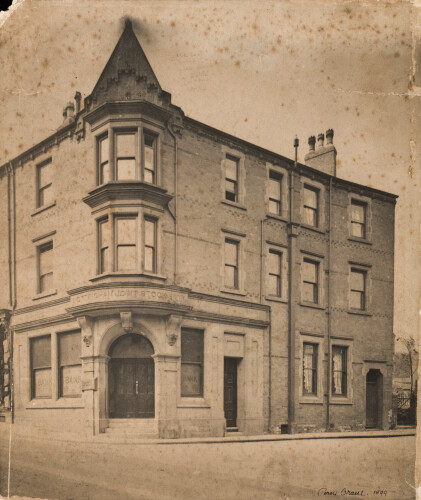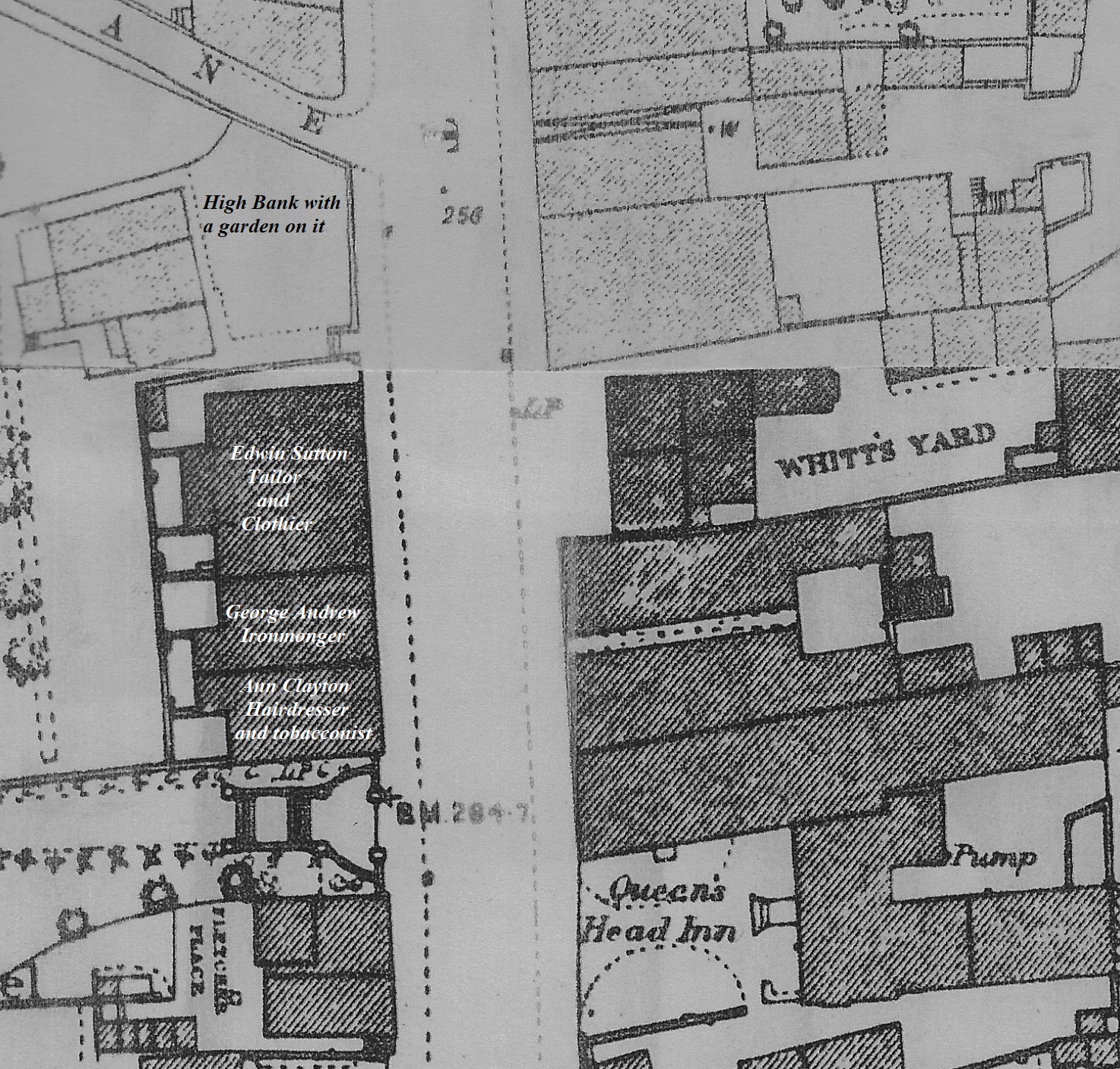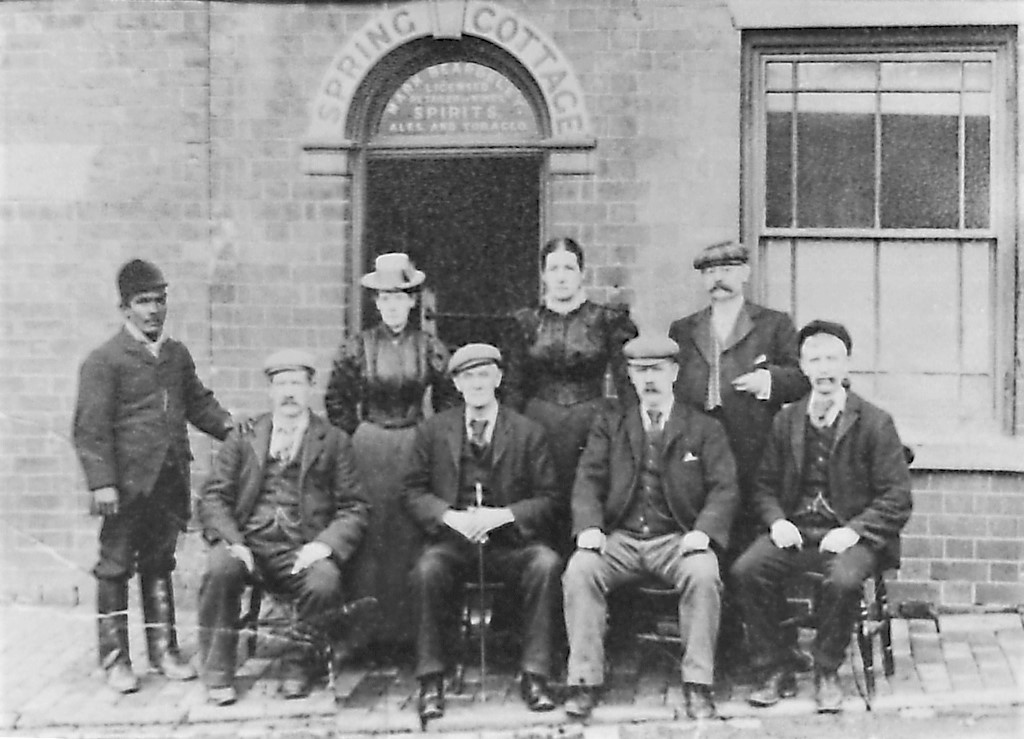Where are we now ?
Before walking on from the short-term residents, let’s take a brief look at what and who we have just seen, using the map of 1880/81 above — which I have included once more, so that you don’t have to keep skipping from page to page (and especially for those not too familiar with the town).
We are walking northwards along the west-side of Bath Street, from the bottom to the top of the map. Just past Mount Street, where Jonty Trot lived, was Mrs. Burgin’s butcher’s shop and Eleanor Boughey’s Girls’ school, just before the British School (bottom) behind which was Club Row and its confusing residents. Then there was a row of tradesmen’s shops, opposite the Alms Houses.
We eventually arrive at the site of the first Bath Street Wesleyan Methodist Chapel, opposite the Queen’s Head Inn and Bostock’s Row. In front of the chapel are a couple of houses named ‘Fletcher’s Place‘ (which you can find on the 1871 Census) and at the south side of the chapel and its schoolroom are the four cottages which constitute ‘Mount Row’ (also on the 1871 census). Notice how the chapel stands well back from Bath Street, leaving a large area where the second Bath Street Wesleyan Methodist Chapel was later built. (It was much later the site of Wilko Store, which has also recently closed — 2023)
Incidentally, the area of Ilkeston off the map, to the left (west), was undeveloped in 1881, consisting of gardens, orchards and fields.
————————————————————————————————————————
At this point let us introduce ….
The Fletcher family of Samuel and Ann
We are now opposite the Queen’s Head Inn, at 23 Bath Street on the 1871 census. Adeline points out that “then came the slope, a road leading up to Samuel Fletcher’s house and factory, which stood on the site now occupied by the Wesleyan Church and School in Bath Street, and was a very old building. House and Factory were incorporated under the same roof.”
Samuel Fletcher (1789-1857) and wife Ann (c1789-1870)
Samuel Fletcher senior, lace manufacturer and framesmith of Bath Street, married Ann (nee Stockley) on February 13th, 1814. Adeline was only two years old when Samuel senior died in 1857.
In January 1857 he was returning by train from Nottingham but fell asleep during his journey, missed his stop at Ilkeston and ended up at Langley Mill.
Initially the station master there demanded that Samuel pay the full fare from Nottingham but when Samuel produced his Nottingham to Ilkeston ticket he was asked only for the excess fare to Langley Mill. Samuel was indignant and refused to pay whereupon he was locked in the booking office with the station master while the latter completed his duties.
Eventually the two of them were about to set off to see Robert Noon of the Shipley Boat Inn who might vouch for the framesmith when Samuel fell and suffered a compound fracture to his right leg.
After treatment by a local surgeon he was returned home where he was placed under the care of Dr. George Blake Norman.
However a week later — on January 12th — he was dead, ‘mortification’ having taken place.
Ann died in 23 Bath Street, their family house adjoining the lace factory, on February 18th, 1870. She was attended by her daughter-in-law Judith (nee Beardsley) in her final hours.
———————————————————————————————————————————————
The children of Samuel and Ann Fletcher
In the description which follows, Adeline is recalling only three sons of Samuel and Ann – she remembers that “the three brothers were in business together”.
a) Joseph Fletcher (1816-1901)
Joseph was the eldest of the three Fletcher sons mentioned by Adeline, born in Nottingham in 1816; he married Ann Hawley, daughter of John and Mary (nee Burgin-Richardson) of South Street on May 16th, 1842.
Adeline recalls that “Joseph had not any children”. She may be thinking of someone else because Joseph Fletcher’s marriage to Ann Hawley was followed by the birth of at least six children before Ann died on May 2nd, 1851, aged 32, from complications shortly after the birth of her daughter Ann, and while the family was living in South Street.
“He retired and lived by himself in a house built by himself next door below William Wade, the grocer”.
Joseph appears to have moved into his Bath Street house close by William Wade, soon after the death of his first wife, in the 1850’s and the 1861 census shows him there but not alone. He is now with his second wife Sarah (nee Hardstaff) whom he had married on January 15th, 1860, and daughters, Sarah Ann and Hannah from his first marriage. Sarah Hardstaff was the eldest child of joiner William and Phoebe (nee Hooley) of Arnold, Nottingham.
At this Bath Street address – number 82 — Joseph retired and here also his wife Sarah died, on November 29th, 1887, aged 75.
Almost exactly two years later, on November 27th 1889, Joseph married his third wife, Sarah (nee Meads) the widow of Nottingham beerhouse keeper John Holmes, whom she had married on October 3rd, 1872. Joseph and Sarah then moved to Beeston and eventually to Nottingham.
Joseph died at 125 Noel Street in Hyson Green, Nottingham on March 1st 1901 but was returned to Ilkeston to be buried in St. Mary’s graveyard, lying then with his second wife.
Before his first marriage Joseph may have fathered an illegitimate son with Sarah Cockayne, daughter of William and Mary (nee Chambers).
Born in December 1838 the boy — Joseph Fletcher Cockayne — lived at the Common and later at Trumpet Yard, Cotmanhay, with his mother who on February 22nd, 1850 had a second illegitimate child, Mary Ann Cockayne.
On March 14th, 1868 Joseph Fletcher Cockayne married Mary Richards, the daughter of Cotmanhay coalminer Joseph and Sarah (nee Booth) and for the rest of his life lived in the Cotmanhay area, dying on April 17th, 1909 at 3 Ash Street.
Both at his baptism and at his wedding, lacemaker Joseph Fletcher was declared as his father.
Still unmarried, his mother Sarah Cockayne died on March 28th 1889, at the registered age of 68!! (Her baptism record indicates that she was born in July 1815).
Sarah’s illegitimate daughter Mary Ann gave birth to her own illegitimate daughter Elizabeth Ann Cockayne on April 4th, 1872.
On February 2oth, 1873 Mary Ann married Eastwood-born coalminer Joseph Meakin – and settled down for a time in Trumpet Yard.
b) Matthew Fletcher (February 1st, 1819-September 19th, 1881)
Adeline states that “he left the (lace) business and became the first landlord of the new Havelock Inn in Stanton Road” where we can meet him.
c) Samuel Fletcher junior (July 3rd, 1828-September 26th, 1892)
“He was left to carry on the business. He made fine hair nets for H. Carrier & Sons.” Adeline recalls that “Sam (junior) had three daughters and two or three sons”.
Born at Ilkeston on July 3rd 1828, Samuel Fletcher junior was the youngest son and on October 31st, 1850 married Judith Beardsley, daughter of Kirk Hallam labourer Thomas and Alice (nee Phipps). Their first three children were daughters Alice, Eliza and Amelia. Their remaining seven children were sons … Samuel Joseph, Allen, Tom Walter, Edwin, Felix, Willie and Arthur Edgar.
—————————————————————————————————————————————-
Tom Walter Fletcher (September 6th 1861-May 13th 1941): villain or victim ? A Victorian Melodrama
Was Tom Walter (1861-1941) the Black Sheep of this family ? … a charge made against him because of his relationship with a young woman, nine years his junior.
Part 1 : Seduction: Hannah Elizabeth’s story
https://visitvictorianengland.com/category/etiquette/
Hannah Elizabeth Bland was aged 19 when she moved to Ilkeston from Riddings near Alfreton in the summer of 1889 with her parents, Samuel and Harriet, and several of her siblings. The family settled in Market Street where her father traded as a butcher, while Hannah Elizabeth was employed as a certified schoolmistress at Chaucer Street schools. Living next door to the Bland family was Allen Fletcher, fabric and silk manufacturer, and his wife and two children … and Allen’s younger brother, Tom Walter, as a boarder. Both brothers worked in the family firm, Samuel Fletcher and Sons, by then based in Wood Street.
A few months after her arrival in Ilkeston, in December 1889, Hannah Elizabeth was at a dance at the Town Hall and happened to encounter Tom Walter. They seemed to strike up a mutual attraction, and afterwards began to ‘walk out together‘ and apparently soon spoke of engagement and marriage. Hannah Elizabeth had heard that Tom Walter was already engaged and when she raised this matter with him, he vehemently denied it … “Most certainly not ! I shall marry you if you’ll wait for me. There is a little obstacle in the way at present, but if you will trust me, I will marry you”. He admitted that he had been engaged but had broken off this agreement; the lady had since been offered marriage by another man, which he hoped she would accept. Then he would be able to marry Hannah Elizabeth — otherwise there was a possibility that ‘the other lady’ might sue him for breach of promise. This was what Hannah Elizabeth wanted to hear and assured him that she was in no hurry for marriage and didn’t mind how long she had to wait. Tom Walter then began to visit the Bland household every Sunday, shared meals there, and even called the Bland parents ‘Mum’ and Dad’. When, in August of 1890 Hannah Elizabeth went to call on friends in her home town, Tom Walter visited her there and was introduced as her ‘intended husband‘. This was followed by an occasion in February 1891 when Hannah Elzabeth’s parents were away from the home, leaving her more freedom than she was usually accustomed to. As a consequence Tom Walter had visited the house and had ‘seduced his sweetheart’.
By the time of her 21st birthday in April 1891 Hannah Elizabeth was pregnant, though this was a secret to most of those around her — although she did reveal her secret to her mother and her sister. Tom Walter had consistently stated his wish to marry her and now Hannah Elizabeth asked him to fulfill that promise … but suddenly he was not so sure !! It appears there was something in the way, and that ‘something‘ was that he was already engaged to someone else !! However, as Hannah Elizabeth’s confinement developed Tom Walter arranged for her to ‘escape Ilkeston’, lodge at Matlock, posing as ‘Mrs Sylvester’, and wearing the wedding ring he had bought for her (from Bath Street jeweller Henry Beaumont). All that time, he wrote to her, expressing his affection and reassuring her that the problematic situation they found themselves in would be soon resolved. “I will make an effort to see you. My position at home is not very rosy. No doubt I shall decide upon something definate before the year is out”.
What Tom Walter failed to tell Hannah Elizabeth (and all his and her relatives and friends) was that he was already married — on November 29th, 1890, at St Pancras Register Office, to Beatrice Belton, whose widowed mother owned a London Hotel — this was three months before he had ‘seduced’ Hannah Elizabeth at her Market Street home. His wife remained living with her mother while Tom Walter kept her existence a secret from everyone. (If you look on the 1891 Census you will find him at 49 Market Street, Ilkeston, lodging as ‘the brother’ of Allen and ‘single‘)
The couple’s child was born at Matlock on 29th October, 1891 and registered as Dorothy Bland Fletcher, with Tom Walter as father. But, try as hard as he could, the truth of Tom Walter’s predicament leaked out and by March 1892 he was having to explain himself to the mother of his child and to some very irate relatives. Hannah Elizabeth was distraught and fell very ill; her mother demanded an explanation from Tom Walter and one was immediately forthcoming — he thought his wife Beatrice, who was very ill, would die and then he would be free to marry Hannah Elizabeth !! But soon his contrition began to change into belligerence.
Tom Walter’s wife objected to the regular payment which he was now paying to Hannah Elizabeth and he concurred … “The best I can do is give you £2 per month. Considering the enormous expense I have been put to in this affair, you must admit this is a very liberal allowance. I should have been at no expense had I thought matters would have become so known. You yourself alone are to blame for whatever has become public”. The allowance was for their child and nothing for the mother. “You must look after yourself. You must know that any explanation is quite unnecessary”. He then bought Oak Lodge, a very comfortable residence in the Alley (later Hardy Street) at Kimberley, Nottinghamshire and moved in with his wife Beatrice. It was at this point that Hannah Elizabeth’s restraint was severely weakened — she sued Tom Walter for substantial damages for the wrong he had done to her.
Here I ask you to pause for a few moments, to reflect upon where your sympathies lie in this case. Had Tom Walter given the impression that he wished to marry Hannah Elizabeth ? Had he behaved ‘honourably’ towards her or was he deliberately manipulative ? Was Hannah Elizabeth too gullible ? Should she have been more questioning, more assertive ? Was her story believable ?
Part 2: Promiscuity ?: the Court Case
The Case of Tom Walter’s ‘Broken Promise of Marriage’ came to court in March 1893, at the Derby Spring Assizes, where the charge against him, as outlined above, was laid out — but where a very contradictory account was set out in his favour. In his version, Hannah Elizabeth appeared as a more promiscuous and devious actress in this domestic drama. She was not a passive servant to his wishes but had thrown herself at him on numerous occasions. With him, she had planned a visit to Matlock in May, 1890, and had willingly stayed with him in the same bedroom. This was many months before her ‘seduction’ by Tom Walter — something she now denied although the evidence suggested that on this point she was now lying.
His counsel asked that ‘morality’ should be put to one side and the jury was only ‘to weigh and consider basic facts’; had Tom Walter ever promised ‘marriage’ ?
After 40 minutes of deliberation the members of the jury were unable to agree and so a majority verdict was accepted — that verdict was in favour of Hannah Elizabeth who was awarded damages of £250. Obviously some members of the jury were very dubious about the veracity of Hannah Elizabeth’s story
The Derbyshire Courier (March 25th 1893) certainly knew who was telling the truth … its headline ? “The Case of the Deceitful Silk Manufacturer”.
Part 3: Maintenance: Hannah Elizabeth asks for support
It is now May 1893 and we are over the county border, at Nottingham Shire Hall — this is because Hannah Elizabeth had moved to Cossall to live. She was now asking that Tom Walter should contribute 5s per week towards the ‘maintenance and education’ of their daughter Dorothy up to the age of 16.
Despite much heart-rending entreaties by Tom Walter’s solicitor — about how much he had spent on Hannah Elizabeth during their ‘affair’ and how much he had had to pay already, in damages, how he now had a wife and two other children to support, and how he had a very large house to maintain (I just made that last bit up !!) — the Nottingham magistrates awarded what Hannah Elizabeth had asked for … which was also the maximum that the court could award !!
Part 4: Perjury: Hannah Elizabeth has to defend herself
Even before Hannah Elizabeth had been awarded her financial settlement, Tom Walter had started proceedings against her — for perjuring herself, and perhaps in the hope of reducing any payments he would have to make to her. (If this was a motive, it hadn’t worked !!) After a preliminary hearing at Derby Police Court in March, Hannah Elizabeth had to attend Derbyshire Summer Assizes at County Hall in July 1893 … this time as the defendant and not the plaintiff, being defended against a charge of committing ‘wilful and corrupt’ perjury. The alleged lies centred around her statement that her ‘seduction’ of February 1891 was the first occasion of intimacy, and that she had not shared a bedroom at Dovedale Lodging House with Tom Walter during the visit to Matlock before that time, in May 1890.
According to Tom Walter, he first became intimate with Hannah Elizabeth in January 1890 and this had continued until their May visit to Matlock. The landlady of the Matlock lodgings confirmed that the couple had stayed together there, in the same bedroom, as husband and wife. This testimony occupied most of the first hearing at the end of which, in early evening, Hannah Elizabeth fainted and remained unconscious for ‘a considerable time’. Though on bail she was not fit to return home and so spent the night at the County Hotel in Derby, ready to reappear for the next day’s proceedings.
During the next day there was little symapthy within the court for Tom Walter and his actions in bringing this case against Hannah Elizabeth. Her counsel scoffed at his claim that he had brought the charge of perjury ‘in the interest of justice‘ .. “this is your last step in the persecution of this unfortunate young woman. You stand condemned by every honourable man who knows the facts of the case. Your evidence should be rejected”.
The Judge summed up: — “This is a very painful trial; painful to the jury, painful to me, painful to every one who has heard it. It might very well be that so far as this poor girl is concerned the jury is full of sympathy for her; it might well be that although some matters are matters as to which the girl on her oath made a false statement and were material to the issue of the breach of promise trial, the jury might feel, as I believe they do feel, that when she made those false statements, she made them not with a view of not supporting her own case against the prosecutor; not with a view of proving the promise of marriage; not with a view of getting larger damages, but with a view of concealing from her family as much of her shame as she could”.
He warned against members of the jury allowing this sympathy to cloud their judgement (although he seemed to have fertilised this sympathy rather successfully). He then when on to warn them about any negative view they might have of Tom Walter, any feeling of disgust they might have for him !! And then he really put the boot into the Ilkeston lad. “It might be that the sight of Fletcher, that cold, cynical scoundrel who stood in the witness box yesterday without apparently a single sense of shame about him, glorying in his misconduct to that poor girl, not ashamed to state to the jury that she was not the only girl he had ruined in that way”. Again, they should not allow this disgust to influence their decision.
And then the judge put one last thought into their collective mind — “When this trial is over the prosecutor will not go entirely unpunished. I do not know where Fletcher lives, but wherever he lives and with whomsoever he associates, he cannot doubt that those people, if they are men and have any knowledge of the facts of this case, will shun him. I hope that the people in the place and neighbourhood where he lives, whether they are people of his own rank or people of an inferior rank, or whether they are the very beggars in the street, will know him and shun the side of the street on which he walks. Depend upon it punishment will follow that man, although it might not be the punishment of the law”.
The judge then looked around the courtroom and saw that Tom Walter had left …. he had described him as a man without shame but he had seemingly done him an injustice, as he had slunk out of court !!
At this point the jury retired, returned 20 minutes later with a ‘Guilty’ verdict but with a strong recommendation for mercy. This is precisely what was shown by the judge when he sentenced Hannah Elizabeth to prison for four days, to be reckoned from the beginning of the Assizes, which was, of course, four days ago. She was immediately discharged. The costs of the case, he added, would not be borne by the ratepayers of the county but would fall instead upon Tom Walter. Througout this part of the proceedings there were constant bursts of applause, “which were time after time suppressed”.
Part 5: Happiness ?
Tom Walter continued to work with the family business at Ilkeston., as he continued to live with his wife and children at Oak Lodge in Kimberley. They had seven children together and eventually moved to Algoa House on Private Road in Sherwood, Nottingham. At his death in 1941 he was still a managing director of the firm. His estate was valued at over £43,000, left to his wife and children.
Hannah Elizabeth married assistant teacher Frederic Stowell in 1899, and eventually settled at Derby Road in Nottingham, where Frederic was headteacher at Manvers junior mixed school. The couple had four children. She died on October 14th, 1941 at 330 Derby Road, while Frederic died there in 1947.
Dorothy Bland Fletcher lived initially with relatives, moved into domestic service, married John T Brown in 1912 (using the surname ‘Bland’) and died in Nottingham in 1980. Her husband died seven years before her.
—————————————————————————————————————————————-
The Fletcher business moved from Bath Street to Wood Street in 1872 and the new Wesleyan Chapel was then built on the site of their old factory.(see below)
Judith Fletcher died on October 12th, 1890, aged 64, at her Chaucer Street home. Husband Samuel died almost two years later, aged 60. They are buried together at Kirk Hallam parish church where their grave can be found, in the plot to the right as you walk through the entrance gate.
“Samuel was also an inveterate poacher, not because he could not maintain his family, but solely for the sport. He was caught once and hauled before John Radford Esq., Magistrate at Derby. The poaching fraternity called him ‘Jackie Radford’.
“When Sam was asked why he had been poaching, he said he did it for a lark. Jackie said we have a cage for larks, and so Sam was caged”.
Magistrate Jackie Radford of Smalley Hall died on March 29th 1866, aged 87, and was buried at Smalley Parish Church. He had been a county magistrate since 1828.
The other Fletcher siblings ?
d) Robert (June 20th 1820-February 20th 1874)
Adeline does not mention this brother, born in Newthorpe. On 4th February 1850 Robert married Mary Ann Pounder, daughter of Shipley labourer Samuel and Dinah (nee Levers) and sister to Samuel junior, the ‘Surveyor, Inspector of Nuisances and Collector of Rates’ for the Ilkeston Local Board.
Robert worked as a warp hand, lived the later years of his life at 18 Wheatley’s Row, off Pimlico, and died there in 1874.
e) Caroline (February 26th 1824 – 1826)
f) Edwin (August 26th 1826 – September 1827)
Gap alert!!
Eldest son was John, born in Nottingham in 1814.
His sisters were Mary, born in 1822 and Ann in 1828.
What happened to them?
——————————————————————————————————————————————————
The Wesleyan Methodist Church.
And now back to the ‘Old Wesleyans‘ whom we left in Market Street.
“When the Wesleyan Church in Bath Street was built, — on the site of the Fletcher factory — the Methodist New Connexion took the small chapel in Market Street”.
It was in November 1873 that the Market Street chapel changed hands for £280 — the Methodist New Connexion purchased it from the ‘Old Wesleyans’.
What were the events that led up to this chapel changeover ?
In the early 1870’s the ‘Old Wesleyans’ were finding the accommodation at their Market Street chapel very restricting especially for their Sunday School. Another disadvantage was that it was situated away from the centre of town, and thus an inconvenience for the congregation.
And so, less than 20 years after moving there, they began to plan for an alternative venue.
Initially a plot of land was purchased in Station Road but was thought to be no better a chapel site than their present Market Street home.
Subsequently, in the summer of 1872, the lace factory and land of the Fletcher family in Bath Street came onto the market and was purchased ‘by the Wesleyans of Mr. Richard Evans’ — for £495 — who enfranchised the property and conveyed it as freehold.
On March 4th 1873 a procession of the Church’s ministers, office-bearers and Sunday-school children marched from the Market Street chapel to the site of the proposed new Bath Street Church.
There two memorial stones were laid, either side of the main entrance, under one of which a lead casket was buried. It contained a parchment recording the date, the names of the persons taking part in the ceremony and the trustees of the chapel, a drawing of the proposed building, the Ilkeston Wesleyan Methodist Circuit Plan, plans of the two Nottingham Circuits, the Ripley Plan, and copies of various papers — The Watchman, The Methodist Recorder, the Ilkeston Pioneer and the Erewash Valley Telegraph.
After this — in April 1873 and via the Ilkeston Pioneer — the old chapel and its land (freehold) was offered for sale, with possesion promised by next August. Any buyer was free to also purchase the internal fixtures, pews, stoves, etc. The Rev. George Butcher was ready and keen to receive any offers !!
Soon thereafter the building of this new Wesleyan Chapel began, standing back from the main road to ensure quietness and privacy. This would be at the rear of the present Wilkinson store. From the outset it was envisaged as a temporary place of worship, the intention being that a larger and more impressive church would eventually be built on the land in front of it. And so it was to be … accompanied by a wait of over 20 years.
Trueman’s History of Ilkeston (1880) refers to the chapel as “an ornamental structure, with a turret at the north-east corner. The windows and principal entrance door are circular-headed, and the building is altogether light and airy. Spacious rooms for the Sunday School are attached”.
Before its completion in 1873 the Pioneer described it as “a neat commodious Chapel, 55 feet in length by 35 in width, with one end gallery for the choir; a school-room, with a spacious class-room for infant scholars; and two vestries for adult Bible classes”.
The Wesleyan Methodist Chapel built on the site of the former Fletcher family factory, as it appeared in an 1877 poster. (courtesy of Ilkeston Reference Library). It is viewed here from its Bath Street side. The Sunday School room can be seen at the rear of the main building.
The first services at the Chapel were held in October 1873 when the opening (on October 2nd) was so popular that some prospective worshippers had to be turned away from the evening service, held in the chapel which seated about 500 people.
At this time the Pioneer quoted a total outlay of £1800 for the new premises, of which £1300 had already been raised – part of it from the sale of the previous Wesleyan Chapel in Market Street to the Methodist New Connexion.
The rest would be raised from service collections, tea meetings, etc. Its final cost was £2,500.
The chapel was constructed by Ilkeston builder Frederick Shaw of Bath Street and later, of Manor Farm, the son of lace mechanic William and Mary (nee Mather).
He had married Marina Matilda Hawley, daughter of South Street butcher John and Mary (nee Burgin-Richardson) in 1855.
And her oldest sister Ann Hawley was married to lacemaker Joseph Fletcher whose family had just vacated this site.
In 1875 further land was purchased, adjacent to and in front of the chapel where some old houses stood …. for £375.
And yet more land was similarly added in 1881. However it wasn’t until December 1895 that the plans of architect George Haslam were accepted — plans for a new church, estimated to cost £4000.
The original chapel eventually became the Sunday School rooms for a new Central Methodist Church, built at the front of the same site.
The memorial stones for this new Church building were eventually laid on October 14th, 1896, the first being by Mayor Charles Maltby, (pictured in the photo) under which were buried a bottle containing copies of local newspapers and a cicuit plan. Its architect was George Haslam of Euclid House in South Street, who can be seen in the foreground with Francis Sudbury, first Mayor of Ilkeston. The church was built by John Henry Vickers and Son of Nottingham.
Laying the foundation stone of the Wesleyan Methodist Church, October 14th 1896. (courtesy of Ilkeston Library)
We are looking towards Bath Street, at the premises of Leeds and Leicester Boot Co. (46 Bath St.) and at the Queen’s Head Inn, now much closer to the road (48 Bath St.) The band is the Derbyshire Rifle Volunteers Band.
The Church was formally opened in March 1898. And in the following month it was visited by the renowned Charles Frederick Aked of Pembroke Chapel, Liverpool, who preached and lectured at the church during its opening services.
The new church of Gothic design, constructed of red bricks with terracotta and stone dressings at a cost of £5500 and seating 730 persons, had a spire 120 feet above the street level and which caused some controversy at the time. William Smith writes that “some of our friends were a little doubtful about the spire, but there was a purpose in it and it was meant to show all around what was going on”.
The same writer also records that many a traveller on the Erewash Valley line of the Midland Railway enquired what the spire was. One man, when asked was given the reply, “It‘s the new Wesleyan Chapel in Bath Street”.
“No, tisn’t”, said a boy correcting him, “it’s the Wesleyan Church in Bath Street”.
“Ilkeston was our climax, and we may fairly assume that for any time within vision so far as church building goes we have seen an ‘end of all perfection’, and no attempt will be made to rival or even come within ‘measurable distance’ of that noble building”. (William Smith 1909)
There was seating for 940 adults and it was then the largest church building in Ilkeston. In October of 1899 the old chapel was closed for renovation, decoration and repair, at a cost of £200, and reopened in November 1899.
The ‘new’ chapel was closed on Sunday May 26th 1968 and its demolition started in 1971.
Demolition underway but the spire is defiant (Nottingham Evening Post/Guardian Journal)
Preparing the site for a new Fine Fare ‘Superstore’ which opened on March 25th, 1975. You can see houses in Gregory Street at the rear. (Jim Beardsley’s Collection)
Fine Fare later became Solo and then it was occupied by Wilkinson’s Wilko from 1999 until the closure of Wilko in 2023.
—————————————————————————————————————————————-
Traffic Warning: September 6th 1878. am.
Henry Knighton, contractor and carter – and landlord of the Granby Arms in Cotmanhay Road – had just about managed to navigate his way up Bath Street from the Ilkeston Boiler Works in Rutland Street. Aided by his employees, he was on board his heavy dray, pulled by 11 horses and carrying a large boiler. But right at the top of the road he came to a halt. The horses could pull no further.
Henry went for reinforcements — more horses – while his men tried to continue the journey.
And that was their mistake!!
The horses were overpowered, the boiler became detached and glided with the dray down the hill.
Just below the Wesleyan Chapel it was stopped in its tracks by the shop front of widow Sarah Orchard (nee Whitfield), grocer and general dealer, causing considerable damage to the brickwork and crushing the windows on the second storey.
Traffic Warning: Thursday a.m. February 17th 1881.
I hope Sarah had buildings insurance!!
A horse and trap were being guided up Bath Street, just past the Primitive Methodist Chapel, when the animal slipped. Thinking that it was about to fall, the driver pulled on its reins and it lurched rightwards, onto the causeway and then straight into Sarah Orchard’s shop window – at number 29A – smashing both panes of glass.
There were no injuries to humans or horse. The collar of the latter was found to be too small and it was suggested that it had had difficulty breathing as it staggered up the steep hill, causing its initial difficulties.
—————————————————————————————————————————
The Sutton Brothers at the corner of Bath Street and Wilmot Street, formerly Spring Lane
Before we carry on down Bath Street, as we are about to cross over Spring Lane (Wilmot Street), we will pause at the property of the Sutton brothers, Edwin and Josiah.
Edwin Sutton (born in Leicester on September 10th, 1854) had married Julia Hull on November 2nd, 1875 in Nottingham and shortly after this, the couple moved into Ilkeston. In 1876 Edwin had bought four freehold shops — numbered 22 to 25 — on the west side of Bath Street, just below (north of) Fletcher’s Place and Edwin used the two shops, 24 and 25, to trade as a tailor and clothier. Originally these were two separate shops, each with its own doorway and shop front but about 1879 alterations to the premises caused the window of number 24 to be lowered about 10 inches, and by 1883 the two shops had been restructured as one.
By 1888, with the renumbering of Bath Street, the four shops were now numbers 57, 59, 61 and 63. Edwin later conveyed the properties to his younger brother Josiah by deed who thereby ‘inherited’ the business. By 1900 number 57 was occupied by Messrs. Hunter, tea dealer, on a lease which was due to run out on August 31st, 1901, at a cost of £55pa. Number 59 was leased to Herbert Bostock, refreshment house keeper, at £60 pa., the lease expiring also in 1901. Numbers 61 and 63 were occupied by Josiah who was trading there as ‘tailor and clothier‘.
The Sutton premises (left) in Bath Street (from a postcard by Ilkeston photographer Edward Bullock Turner)
Herbert Bostock’s restaurant can be seen on the left of the photo above, and then the two extended shop canopies of Josiah Sutton’s shop. Opposite his premises, across Bath Street at numbers 54 and 56 and about 33 feet away, was the business of furniture dealer Joseph Briggs. Before this was established, there used to be two older cottages on the site, standing 10 feet back from the road and in front of what was known as Whitt’s Yard. They were about 25 feet tall and about 20 feet wide
Whitt’s Yard alias Sweep’s Yard c 1890 (Trueman and Marston)
On the north side of the cottages (left in the photo) was an open passageway about eight freet wide, which led to the cottages of Whitt’s Yard in the rear. In 1893 the two front cottages were pulled down and the site remained vacant for several years until, in 1899, the property for Joseph Briggs’ business was built there. It was much taller than the cottages had been and was built up to the street frontage line. The new buildings caused friction between Joseph Briggs and Josiah Sutton, the latter now complaining of “loss of light” which was significantly affecting his business.
(to be continued)
The Nottingham Joint Stock Bank
This bank was founded in Nottingham, opening for business from premises in Low Pavement on 1st September 1865, to meet the needs of the rapidly expanding lace and hosiery industries in that city. A branch was then opened in Ilkeston in October 1865. It is listed in Ilkeston in the Harrod & Co Trade Directory of 1870, with its manager Percival Nuttall at “Bank House, Market Place“. Percival is also recorded on the 1871 census at 1 Market Place. The bank moved into its new freehold Bath Street premises, also named ‘Bank House’, in December 1885. This was later 63 Bath Street and was one of the Sutton properties. The photo below shows the premises in 1899 (from the HSBC website). By this time the manager there was Thomas Blagg Marsh, who had taken over in 1895. He was the son-in-law, since 1891, of Dr. Robert Wood. Wilmot Street (formerly Spring Lane) is on the right while the business of Josiah Sutton is just off the left.
———————————————————————————————————-
Now Adeline directs us to “a high bank with a garden on it”. I am not certain of its precise position: on the 1880/1881 map below I have indicated where it might be, at the junction of Bath Street and Spring Lane.
At this point was Spring Lane down which, on its right hand side, was the Spring Cottage Inn. Let’s drop in for a pint ?
Can you read Mark Beardsley’s name above the door ? … but which Mark is it ?

